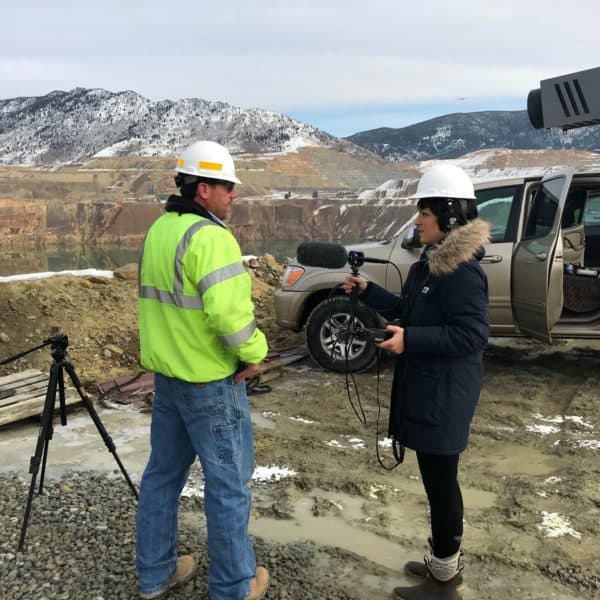Advertisement
Unwrapping the lost history of Confectioner's Row
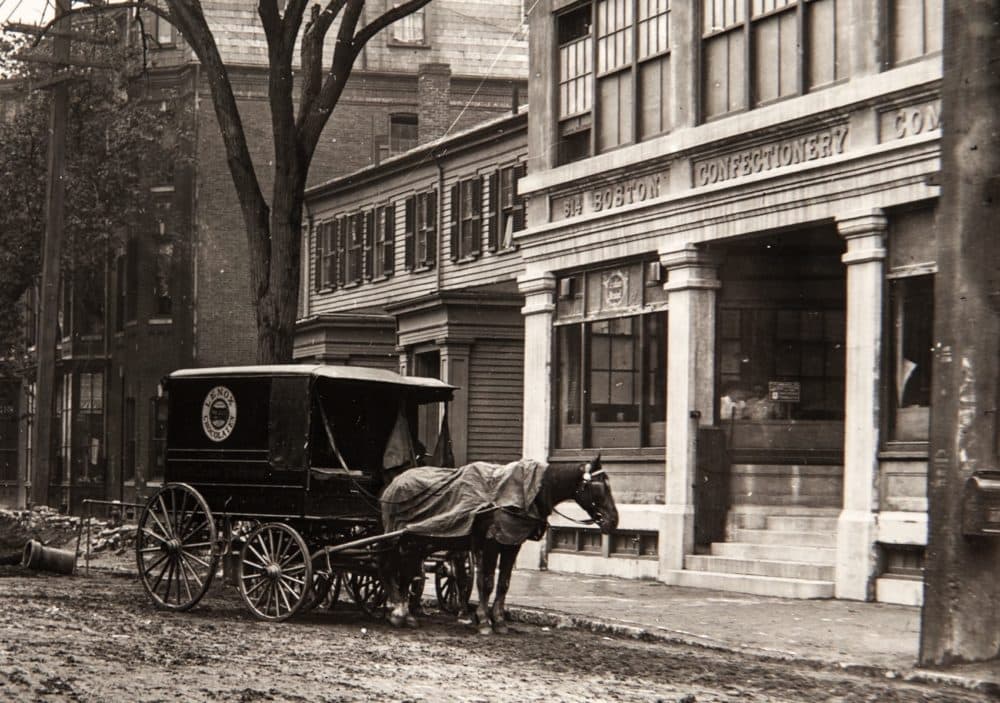
For years, WBUR senior arts and culture reporter Andrea Shea drove by an old, mysterious factory in Cambridge, Massachusetts. To her surprise, it turned out to be the very last vestige of a 20th century candy hub called Confectioner's Row — the birthplace of America's candy industry.
This booming manufacturing center was home to dozens of companies that concocted every sweet imaginable: gum, hard candy, chocolate, and Andrea's personal childhood favorite, Charleston Chews. Eventually, the manufacturing jobs dried up. Now, only one candy factory remains. In this episode of Last Seen, Andrea and candy historian Susan Benjamin walk us through the hidden history of Confectioner's Row and attempt to find a real life Willy Wonka; the CEO of Cambridge Brands.
Big thanks to Susan Benjamin, Charles Sullivan of the Cambridge Historical Commission, Richard Neal, Paula Yetman, Teresa Ruda and Ellen Gordon.

Show notes:
- "Historic candy store has treats that date back centuries" (Voice of America)
- About the Cambridge Historical Commission
Full Transcript:
This content was originally created for audio. The transcript has been edited from our original script for clarity. Heads up that some elements (i.e. music, sound effects, tone) are harder to translate to text.
Nora Saks: When you were a kid did you have a favorite candy? When you close your eyes, can you feel it melting on your tongue or cracking between your teeth?
Well, like a lot of kids in the '70s and '80s, Andrea Shea used to freeze long, chocolate-covered Charleston Chews and she’d smack them on the counter into bite-sized pieces. So, for a little nostalgia, we’re doing it together.
Andrea Shea: Okay, so you just take the bar and hold it in your hand. And you just … (Whack.)
Nora: Wow! Let me try! (Whack.) Ooh, that feels good.
Andrea: And you can keep doing it until it smacks into a whole bunch of little pieces.
Advertisement
Nora: Is this so it doesn’t like, crack your teeth?
Andrea: It was a commercial.
[Charleston Chews commercial audio:
“You love to chew it, fun to do it. Charleston, a little chewy chew…”]
Andrea: Everyone was doing it. You know, you go to the penny candy store and buy Charleston Chews. Ride your bike over, fill your paper bag and come home, stick it in the freezer, and…
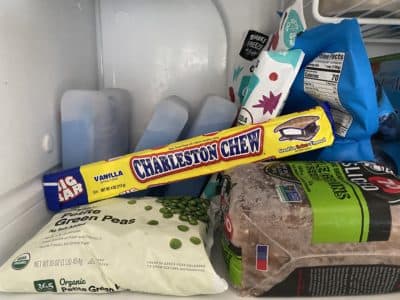
Nora: Smack away.
Andrea: Smack away.
Nora: I love it.
Andrea: And actually they called it the Charleston crack.
Nora: Charleston crack, I'm going to put that in my pocket. Andrea, a few years back you learned something that blew your mind: that every Charleston Chew in the world is made in Cambridge, Massachusetts – not far from where you live.
Andrea: Ha, some reporter I am. I’ve driven by that old building so many times and I had no idea it was a candy factory.
Nora: And it turns out that factory is the last vestige of a major, 20th century candy hub known as Confectioner’s Row.
Andrea: Right, so Confectioner's Row was this place that for decades, dozens of companies and they concocted every sweet imaginable there. Gum, hard candy, chocolate. It was said that they filled the air with intoxicating, sugary aromas of iconic brands, like NECCO Wafers and the Charleston Chew.
Nora: And Andrea, you wanted to know what happened to this place, Confectioner's Row.
Andrea: For what feels like forever, I’ve been so curious with why this booming hub disappeared, and whether there were any pieces of it left.
Nora: Welcome to Last Seen, our show about people, places and things that have gone missing. Coming at you from WBUR, Boston’s NPR station.
I’m Nora Saks.
Today, with WBUR senior arts and culture reporter Andrea Shea – we invite you to explore … lost Confectioner's Row.
Andrea: $37 billion dollars. That’s how much money Americans spent on their sweet tooths in 2021. Most of that candy was manufactured in places like Illinois and Pennsylvania … but the American candy industry was actually born in Boston.
Starting in the 1800s candy making boomed across the Charles River in Cambridge, along a 1-to-2 mile stretch with a tantalizing name: Confectioner's Row.
There’s almost no evidence of it now, even if you scoured the neighborhood. Almost any sign of that booming industry has gone missing.
There’s stuff online about it, but I wanted to know more. Then I found someone who got to experience the tail end of this mythic place.
Susan Benjamin: Out of the side door of the NECCO factory they had a little store and it was only open I think it was on Thursday and only for employees where they could go and buy candy cheap.
Andrea: When Susan Benjamin was a young hippie in the 70s she loved those chalky, multi-colored NECCO wafers and made pilgrimages to the factory.
Susan: And I'm going to tell you, that smell was there, it just permeated.
Andrea: That aroma – of gobs of candy being made, 24/7 – is like a holy grail for Susan. I’ve never met anyone as obsessed with the idea of candy’s power. It seems so personal.
Susan: So when I was young, I was ill, I was out of school, I was bullied, and my life was kind of a misery.
Andrea: Susan found comfort in the candy aisles at pharmacies and penny candy stores. She also used her stash to pay off the bullies.
Susan: I could offer them candy and they would take it, and for that time, if that time only, it was OK.
Andrea: Candy also runs in Susan’s family. Her great aunt, who emigrated from Eastern Europe, found a job in Cambridge along Confectioner's Row. She was an “enrober” who Susan says was super proud of how good she got at putting little swirls on top of chocolates.
Over time Susan turned her obsession with candy into a pretty unique job: candy historian.
Susan: I mean, it was the perfect researcher's universe because hardly anyone was doing it, and the stories were cool. They were about immigrants, they were about enslavement, they were about women in the kitchen and women in the workplace. It was all there and ready for me to do the picking, which gave me also a sense of purpose.
Andrea: These days Susan, who’s 65, channels that purpose into writing books, lecturing and running a “history-based” candy store in Harper’s Ferry, West Virginia.
It’s stocked with vintage brands and reproductions of candy that go back to before the Revolutionary War. Susan’s also something of a media darling.
Deborah Block: It’s a love fest for sweets at True Treats in Harper’s Ferry, West Virginia, the only historic candy store in the United States. Owner Susan Benjamin offers customers interesting tidbits … ]
Andrea: Lucky for me Susan is totally down to come back to Cambridge – in part, because she wants to see the old NECCO factory where she used to get her weekly fix of wafers.
Main Street – where confectioner's row used to be – is nothing like Susan remembers. This area has exploded into an international center of tech and medical research where science has replaced sugar. Vaccine giants Moderna and Pfizer are here, and we’re surrounded by shiny glass and steel skyscrapers.
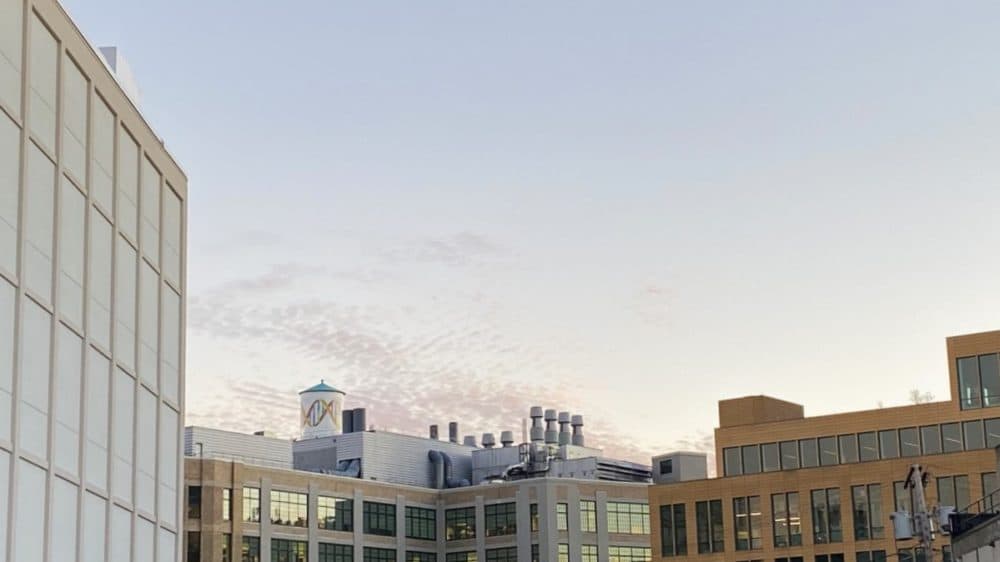
Andrea: So how does it make you feel to be walking around here and looking at all these buildings?
Susan: I know that there’s some existential underpinning here, that there was this huge universe here that went on for miles, so it kind of makes you think, wow, where did it go, and how could it so completely vanish.
Andrea: Susan bets the MIT students and scientists walking past us have no idea about this area’s candy past, and she’s right. At least according to Guillermo Hercules, an MIT lab worker who we stopped and asked about Confectioner's Row.
Guillermo Hercules: What do I know about candy history here? I would tell you nothing. (Laughs.) I don’t know nothing about candy history.
Andrea: Well, here’s some of that history. Back in its heyday horse-drawn carriages and candy mongers lined Confectioner’s Row. But before then the country’s first chocolate mill opened in Boston in 1765. Sugar – harvested by enslaved Africans in the Caribbean – flowed into the harbor and satisfied the colonists’ cravings for sweets.
Sugar might be demonized these days, but Susan says back then it was the backbone of medicines for stomach aches and sore throats. This is when NECCO enters the story.
In 1847, a pharmacist named Oliver Chase patented the first candy machine. He used it to slice thin Chase Lozenges, then the Hub Wafer…
Susan: …and eventually what everybody knows and loves: the NECCO Wafer in the early 1900s.
Andrea: Chase crossed the river to Cambridge where land was cheap and other bootstrapping candy makers were setting up shop. He eventually merged with two other producers to form the New England Confectionery Company – a.k.a. NECCO – and it became a national icon.
[Commercial audio:
Narrator: NECCO was the first to box quality chocolate covered peppermints for 5 cents, and then of course there are the famous wafers that have been popular since before the turn of the century…]
Andrea: NECCO used to be the country’s oldest continuously operating candy company. Now it’s long gone from Cambridge, its brands sold off to out-of-state companies. But the old building is a national historic landmark. That’s where Susan and I head next.
(Seat belts buckle. Car doors shut.)
Susan knows from her research that the pharmaceutical giant Novartis took over the former NECCO factory in 2004. But now that she’s seeing it with her own eyes…
Susan: I can't even talk. I can't believe how upset I am. It's gone, so we're right outside of the former NECCO company, there had always been a NECCO factory. I mean, even when it closed, it was still a NECCO factory. Now, it looks like something else.
Andrea: Show me the door that you used to go to where you think it used to be.
Susan: I don't know, because the first floor has all these windows…
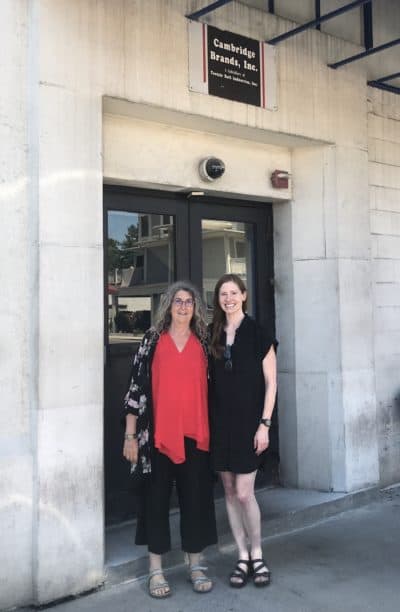
Andrea: Memory is a tricky thing, right? Susan is trying to piece together the pictures in her mind. She feels like a formative part of her past has been lost.
Susan: And there is no smell in the air at all.
Andrea: No hint of sugar, caramel, chocolate. And there’s something else that’s different. The old, cylindrical water tower on top of the building used to be painted to look like a giant, colorful roll of NECCO wafers. Now it wears the twisting strands of a double helix, that symbol of molecular biology and genetic research.
[Commercial audio:
Narrator: When you want to save humans from disease…ask science…]
Andrea: Susan isn't the only one mourning the loss of the neighborhood.
Charles Sullivan: People had enormous affection for NECCO. It was a local landmark.
Charles Sullivan is the head of the Cambridge Historical Commission. He remembers how the community rose up to save the mammoth, rainbow-hued NECCO roll on top of Novartis’s building.
Charles: In people's imaginations, it had always been there and it was something that they felt characterized Cambridge, and they wanted to hang on to it.
Andrea: Charles oversaw Novartis’ renovation of the NECCO factory. His commission’s office is filled with all kinds of vintage stuff from Cambridge’s sugary past – old photos, advertisements, boxes and tins…
Charles: Alright, I need to get me glasses. (Laughs.) We don't have a lot of original records. Most of the companies had disappeared by the time we began collecting things.
Andrea: Before you came to Cambridge did you have any idea Confectioner's Row existed?
Charles (Laughs.) No, not at all.
Andrea: Charles joined the commission in 1974. He digs out some old, musty city directories that list the names of companies along confectioner's row.
Charles: The industrial scene changed so quickly that these companies were always merging and splitting and people were leaving and setting up their own shops. Some of them were just store fronts and some of them were big industrial operations.
Andrea: At the industry’s peak there were more than 60 candy companies in this part of Cambridge. They employed a lot of immigrants– from Italy, the Balkans, the Azores, Eastern Europe. Susan believes jobs in candy uniquely offered them the promise of a new beginning.
Susan: They were people who have been traumatized by the potato famine, if they were from Ireland. By pogroms, if they were Jewish. And then, of course, many of the people who may have moved up from the South, who have African-American descent. So you had people who were there not just to have a nice life, but to have a life at all.
Andrea: Susan imagines what it would have been like to live and work on confectioner's row during its heyday.
Susan: You can smell – as generations could since then, including me – caramel and chocolate and vanilla and just flooding everywhere. And it smells so good.
Charles: It used to be said that depending on the day of the week, you would perceive different smells that would waft over the neighborhood. So it contributed to people's sense of place, as well as the sense of economic security as a source of many, many hundreds of jobs.
Andrea: But a lot of those jobs were actually in rubber and soap factories. Charles suspects Susan imagines Cambridge smelled better than it actually did.
Charles: Human memory is malleable, and if you're a child growing up the smell of candy is just irresistible, it probably imprints itself on your memory. More than the smell of rendered animal fat which can be really intense and nauseating.
Andrea: Over time traditional manufacturing left Cambridge and Charles says the immigrants who worked in those factories followed.
These days, Cambridge smells, well, like most cities I guess. But if you know where to stand – and if the wind is right – you can still catch whiffs of the candy bars I used to freeze and smack into pieces.
(Whacks Charleston Chews.)
Remember we said Charleston Chews are made by the sole survivor of Confectioner’s Row? It’s called Cambridge Brands, and it makes every single Charleston Chew on the planet. But how come nobody seems to know it’s even here?
Charles: They're famously private. They have almost no public profile in Cambridge.
Andrea: In all his decades at the historical commission Charles had never interacted with Cambridge Brands. That changed a few years ago when the company wanted to expand its footprint and needed his help.
Charles: But before that, they were really unknowable.
Andrea: Unknowable, like Willy Wonka’s Chocolate Factory. Maybe you remember that movie’s creepy character who, outside the mysterious building, warns…
[Willy Wonka and the Chocolate Factory (1971) clip:
“Nobody ever goes in, and nobody ever comes out.”]
Andrea: Will Susans’ candy industry cred help get us inside the last candy factory on Confectioner Row? Our search for the Golden Ticket – and a real Willy Wonka – after the break.
[SPONSOR BREAK]
Andrea: As the last remaining vestige of Confectioner's Row that has gone missing, Cambridge Brands is famously impenetrable. It really is like Wonka’s chocolate factory.
But there’s a legit reason for candy companies to be secretive. Maybe you remember Slugworth, the spy trying to steal Willy Wonka's inventions?
Susan says that fiction is inspired by reality because, unlike so many other inventions, candy recipes can’t be patented.
Susan: If somebody walks in there and gets a hold of that formula, you're sunk because now it is no longer your candy. It is available to anybody. And each one of those formulas are literally worth millions and millions and millions of dollars. So when you go to the door, they're not going to let you in.
Andrea: Unless you’re Susan Benjamin. Her charm and industry cred scores us a tour, and a rare interview with the elusive woman behind the curtain at Cambridge Brands.
The old, white industrial building is kind of incognito. I’ve breezed by it countless times, never stopping to sniff, and without spotting the small sign near its entrance. It looks like a big Tootsie Roll wrapper laid flat and simply says, “Cambridge Brands, a subsidiary of Tootsie Roll Industries Inc.” On the sidewalk Susan’s face changes. She looks like a little kid.
Susan: Oh, you smell it. OK, I smell it. Thank you Ellen Gordon!
Andrea: Ellen Gordon is Tootsie Roll, Inc’s CEO. Susan calls her the “grand dame of the candy universe.”
She’s only seen the notoriously media-shy executive from a distance at industry expos. But Susan has never had the chance to speak with Mrs. Gordon.
(Office doors open.)
The company’s head of security lets us in and escorts us to a small room. Other friendly gatekeepers introduce themselves.
Employee: Just need to get you signed in over here.
Susan: Sure.
Employee: I just have some paperwork for you…
Andrea: We’re given some lengthy confidentiality forms. I can’t remember signing anything like them in all my years as a journalist. Susan’s not surprised.
Susan: I mean, the fact we get this far for many places is pretty amazing.
Richard Neal: We're running everything today, so.
Susan: Wow.
Richard: We’ve got Charleston Chew being made on the fifth floor. The fourth floor we're running our Sugar Babies.
Susan: Yes, oh gosh that’s so cool…
Andrea: This is production manager Richard Neal. He used to work for Nestle and says if that company owned this facility it would’ve moved production out west years ago. But it seems CEO Ellen Gordon – plays the candy game her own way.
Richard: Hi, Mrs. Gordon.
Ellen Gordon: Hi, how are you?
Richard: Good. I'm going to take them into the large conference room, OK?
Susan: She’s known to be very charming, family-oriented and oriented toward employees.
Andrea: As Susan whispers some background on this real life Wonka…she reminds me how big this is. Mrs. Gordon almost never gives interviews –
In the conference room a spread of muffins and fruit is laid out on the table.
(Silverware clinks.)
Andrea: The soft-spoken CEO sits down and pours some tea. She reminds me of my grandmother – if my grandmother ran a multi-billion-dollar company. She wears a smart, black suit and a cute Tootsie Roll pendant around her neck. This 90-year-old has known that chocolate taffy her whole life. Her grandfather and parents ran Tootsie Roll Inc. for decades.
What was it like as a child? Were you like running around in a candy factory? It sounds like a dream come true. You were a kid in a candy shop.
Ellen: Yes. I grew up in the candy factory in the sense that on weekends, the biggest treat was to be able to go with my father, to work and to go to the factory.
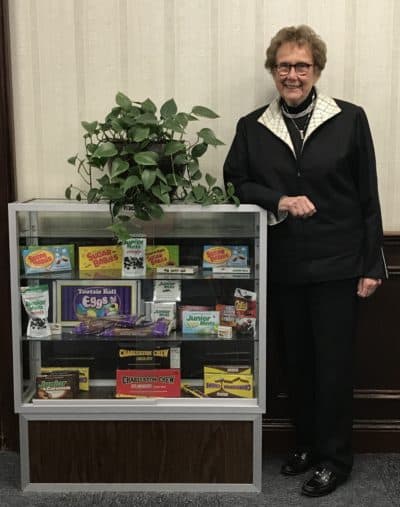
Andrea: Gordon’s family bought initial shares of Tootsie Roll stock when the company went public in 1918. They’ve maintained majority ownership since the 30s. She became CEO in 2015, making Gordon the second female president to lead a NY Stock Exchange company. She remembers riding a lot of freight elevators as a kid. Now it’s our turn.
Ellen: I’m having my Willy Wonka moment. (Laughs.)
Andrea: One staff member jokes we won’t see any Oompa Loompas on this tour.
(Elevator bumps, door closes.)
Richard: This is the fifth floor, our Charleston Chew Department. All of the Charleston Chews in the world are made here. We have a nougat kitchen…
Andrea: And, yes, it smells amazing! We’re given hairnets and walk past vats of egg solution being mixed with a slurry of corn syrup and liquid sugar. Then it gets blown through a network of pipes.
Richard: If you look up there, he's evacuating the nougat from the blender…
(Blender grinds, nougat explodes.)
Andrea: I’m told this production line makes like 5 million pounds of nougat a year. Mrs. Gordon still gets excited watching the sticky, white mass being transformed.
Ellen: It's like spread out over belts, but it's all one great big mass, and then come the cutters, which slice it so that it's in strips.
(Machines slice and cut.)
Andrea: Those cutters are called guillotines, and the candy industry itself is pretty cut-throat. The Charleston Chew itself actually reveals something about why Cambridge Brands is the last major candy manufacturer in Cambridge.
The chew didn’t always belong to Tootsie Roll Inc, but it has been made in this very building since the early 1920s.
Gordon’s family chased the Charleston Chew for decades. And finally, in the 1990s, snatched it up – along with a few other classic brands. It’s part of an ongoing story of consolidation in the candy industry.
Ellen: And that's how Junior Mints, Charleston Chew, Sugar Babies and Sugar Daddies became a part of Tootsie Roll Industries.
[Tootsie Pop commercial audio:
Child: Mr. Owl, how many licks does it take to get to the Tootsie Roll Center of a tootsie pop?
Owl: Good question. Let’s find out. One, two … three … (Crunch.) Three.]
Andrea: But here's a question I'm still grappling with. Even with the rise of science and biotech in Cambridge, and the usual jockey-ing for real estate that happens in cities like this, why did Confectioner's Row go missing? After all, candy is still a whopper of an industry.
Susan says the rise of conglomerates – and their ability to produce and distribute products on a mass scale across the country – gobbled up the little guys along Confectioner's Row.
But, for Susan, Tootsie is different. Sure it earned more than $500 million dollars in 2021 – but it’s been owned by the same candy family for almost a century.
Ellen: Some of our brands go back to the 19th century, and while the process can change, you even have to make sure as you change the process that it doesn't change the texture or the taste because the consumers are very smart. They sense it. They taste it.
Andrea: That happened when new machinery smoothed out the little dimple you feel with your tongue on the bottom of a Junior Mint. Susan loves that story.
Susan: People were outraged. “This is not the Junior Mint. Where is the dimple?” So they went back, they got new machinery and they put the dimple back in because that's how much it mattered.
Andrea: While Cambridge Brands develops new candies and variations – like Mini Chews – Gordon says they never mess with the classic logos and wrappers. People are attached, and striking a balance is a delicate dance.
Ellen: Our lives change, our styles change. And what do we do to keep in style and make it awesome and cool today, what was awesome and cool a long time ago to make sure you're relevant?
Andrea: I think that’s both the question and an answer to our mystery about Cambridge Brands’ survival. And you know, smacking a frozen Charleston Chew bar on a counter is extra cool to me now because it’s essentially a humble, edible vestige of lost Confectioner's Row.
But there’s something else both Mrs. Gordon and Susan seem to get: that deep down candy makes people feel good. Maybe even like little kids again.
Susan: There is that attachment that all of us have. Even people claim not to like candy. They do. I'm telling you, they do.
And Ellen Gordon never grows tired of walking through her candy factory.
As for all the protective secrecy shrouding Cambridge Brands, the CEO smiles and says yup, it’s real and it also makes a good story.
Ellen: If anybody says to me, “What do you do?” And I say, “I work in a candy company” invariably they smile.
Andrea: In 2022, Cambridge Brands installed a new mural to commemorate the lost history of Confectioners’ Row. So now it’ll be a little less forgotten.
And I got to see it in person. Which was pretty sweet.
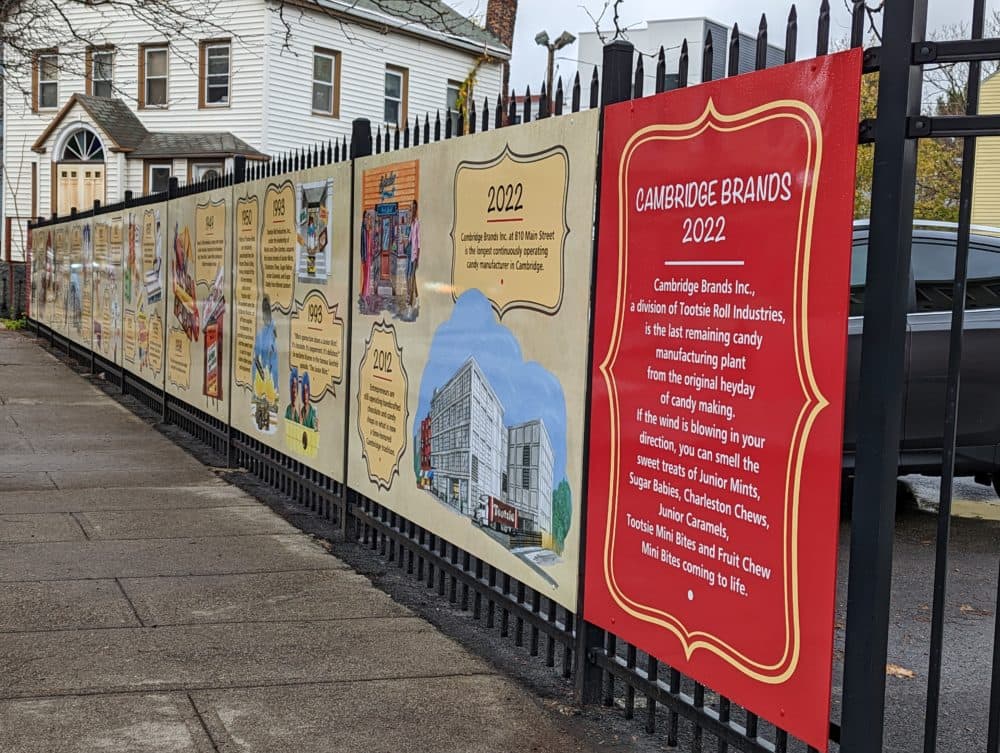
So it goes all the way from, you know, early 1800s to 2022. (Reading aloud.) Cambridge Brands at 1810 Main Street is the longest continuously operating candy manufacturer in Cambridge. And the last remaining candy manufacturing plant from the original heyday of candy making. If the wind is blowing in your direction, you can smell the sweet treats of Junior Mints, Sugar Babies, Charleston Chews, Junior Caramels, Tootsie Mini Bites and Fruit Chew mini Bites Coming to life….
Oh, and there's a picture of the little owl, the Tootsie Roll Owl.
[Tootsie Pop commercial audio:
Owl: One, two, three. (Crunch.) Three.]
[CREDITS]
Nora Saks: This episode of Last Seen was reported and written by Andrea Shea.
It was produced by Andrea and myself, Nora Saks. Jeb Sharp is our story editor. Mix and sound design by Emily Jankowski. Production help from my WBUR Podcasts teammates, Paul Vaitkus, Matt Reed, Dean Russell, Amory Sivertson, Megan Cattel, Quincy Walters, and Grace Tatter. Our digital producer is Megan Cattel. Ben Brock Johnson is our executive producer. Big thanks to candy historian Susan Benjamin, Charles Sullivan of the Cambridge Historical Commission and the generous folks at Cambridge Brands and Tootsie Roll, Inc – including Richard Neal, Paula Yetman, Teresa Ruda and especially Mrs. Ellen Gordon.
You can find all of our stories and show notes at WBUR.org slash Last Seen. And Follow us on Twitter - @LastSeenPodcast
And can always pitch us your story ideas about people, places, and things that have gone missing. Drop us a line at lastseenwbur@gmail.com
Next week – we’re hunting for the real origin of Quebec’s most famous pie.
Thanks for listening.


